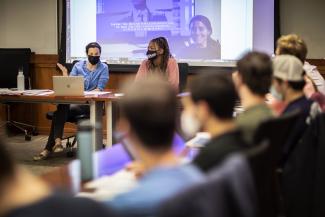
“Are you crying? There’s no crying,” Tom Hanks’ character Jimmy Dugan famously yells at a sobbing player in the 1992 movie “A League of Their Own,” based on the real-life World War II-era women’s pro baseball league. “There’s no crying in baseball!”
However, that’s not the case for students in historian Sarah Gronningsater’s popular History of U.S. Baseball seminar.
“I told students at the beginning of the semester that the majority of the class will either actively cry or admit they had tears welling behind their eyes at least once,” she says. On the last day of class, she took a poll and, indeed, the majority of students acknowledged they had been moved to tears at one point in the spring semester.
“I think it’s because so much of baseball is about people’s relationships to each other, to their families and to the place where they’re from,” says Gronningsater, an assistant professor of history in the School of Arts & Sciences. “If there’s anything that the pandemic taught us, it’s how much relationships matter. Students bring themselves to the classroom in a way that’s particularly magical in this course.”
The history of baseball is, in many ways, the history of the United States, and students in Gronningsater’s class explore those layered histories through a host of topics, from the game’s origins in early 19th-century northern cities, to the professionalization and nationalization of the sport during and after the Civil War, to the Negro Leagues and desegregation, to perpetual tensions between labor and management. Students learn how a wide range of Americans have found baseball at turns inspiring and disappointing—a source of hope at some moments and an institution in need of deep reform at others. Baseball, like the country that created it, has always been intriguingly—sometimes maddeningly—complex.
“Students want to have fun in the classroom but they also have a strong desire to understand something that we call ‘the American Pastime’ and how it fits into American history,” she says. “Now more than ever, people want to understand the country in which they live, and baseball is a vehicle for getting there.”
Read the entire story HERE
